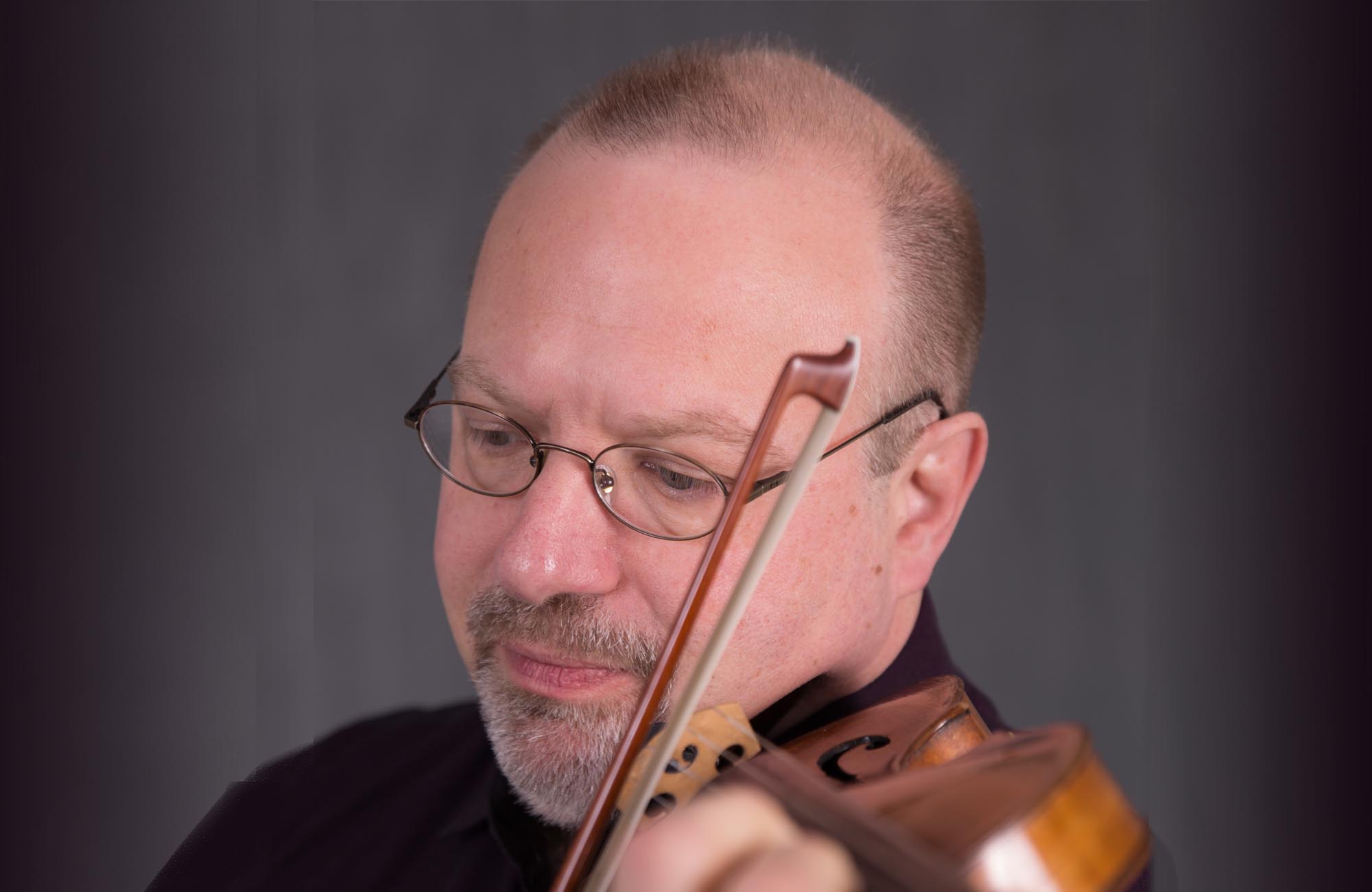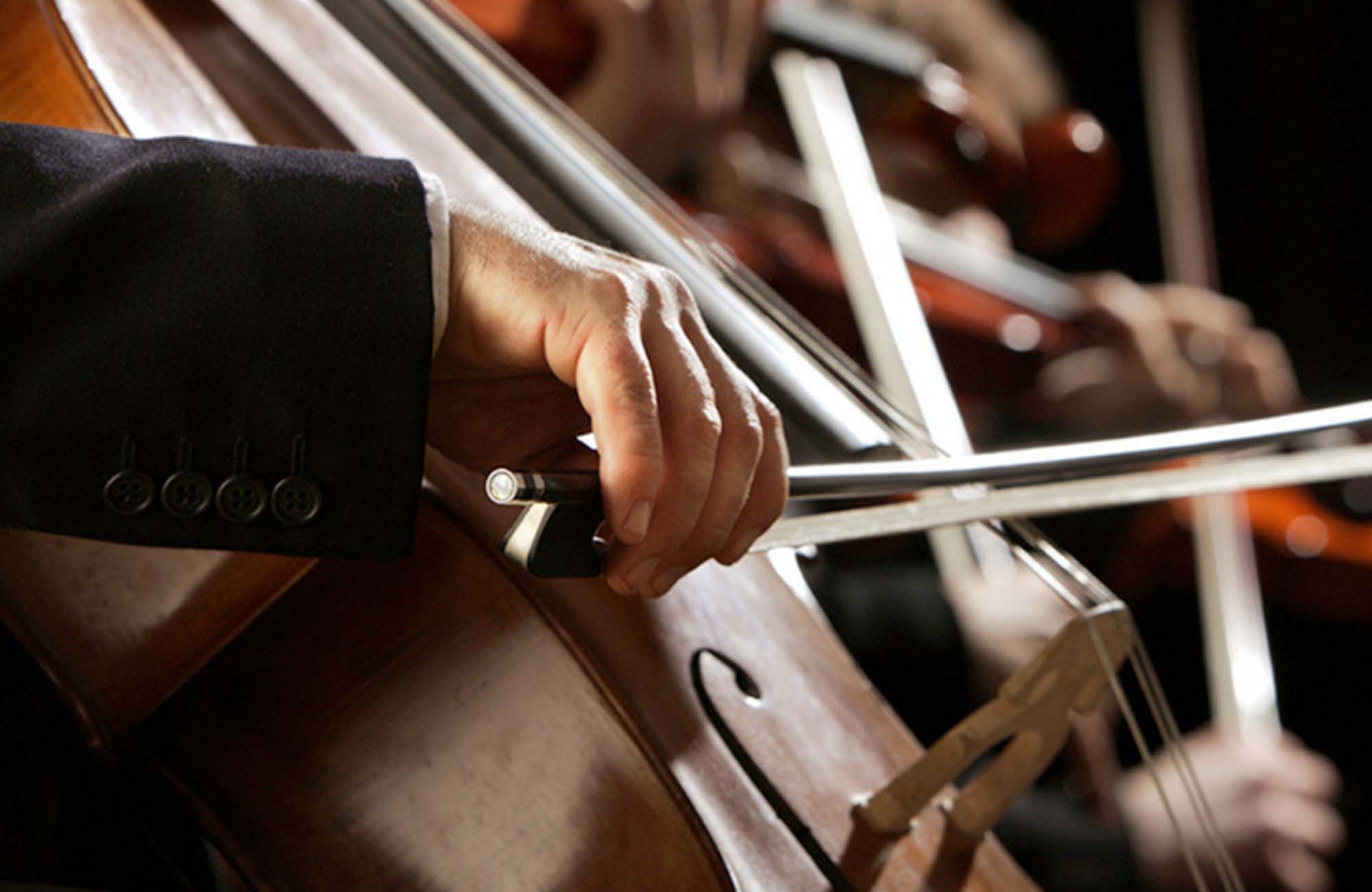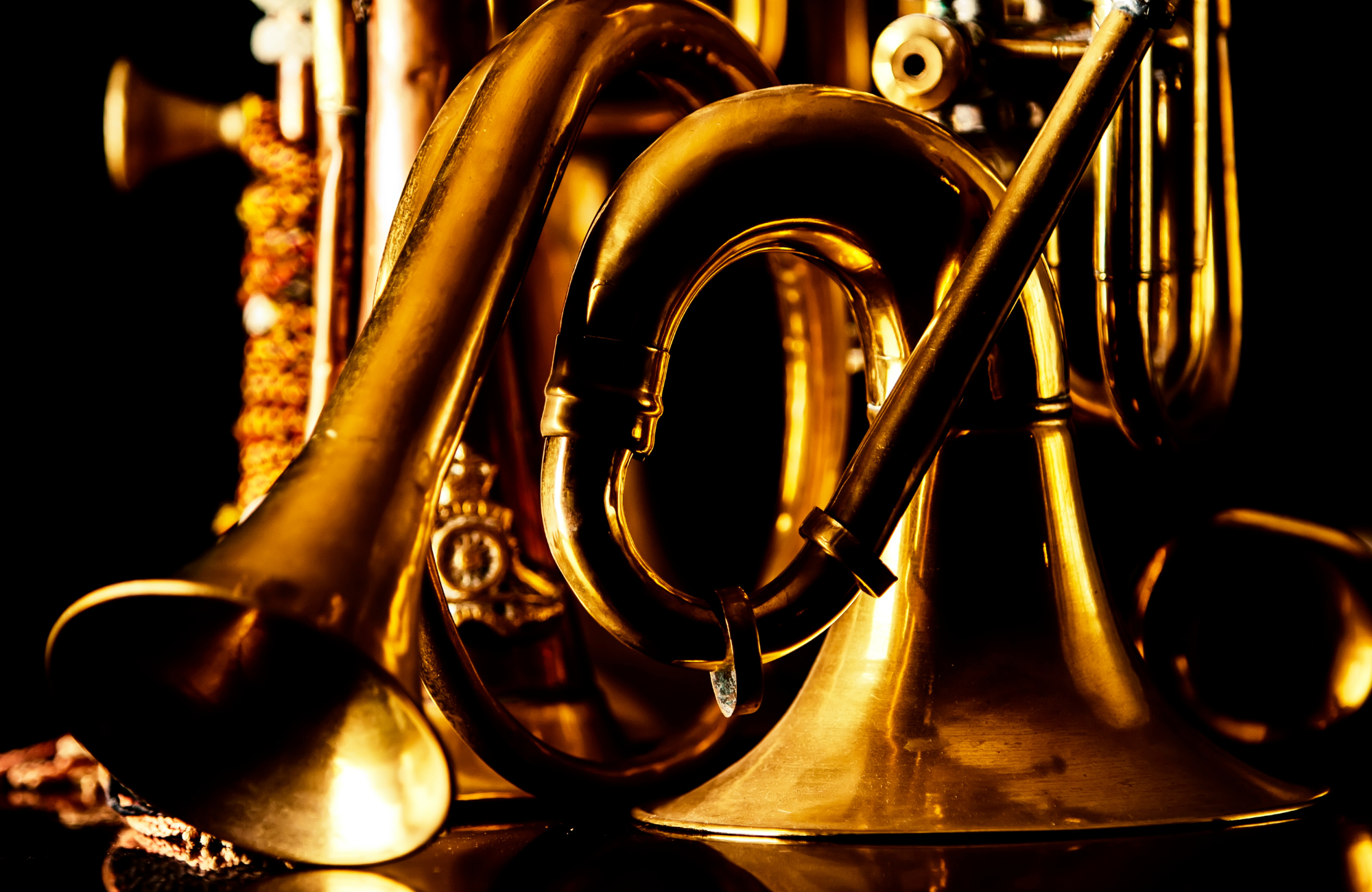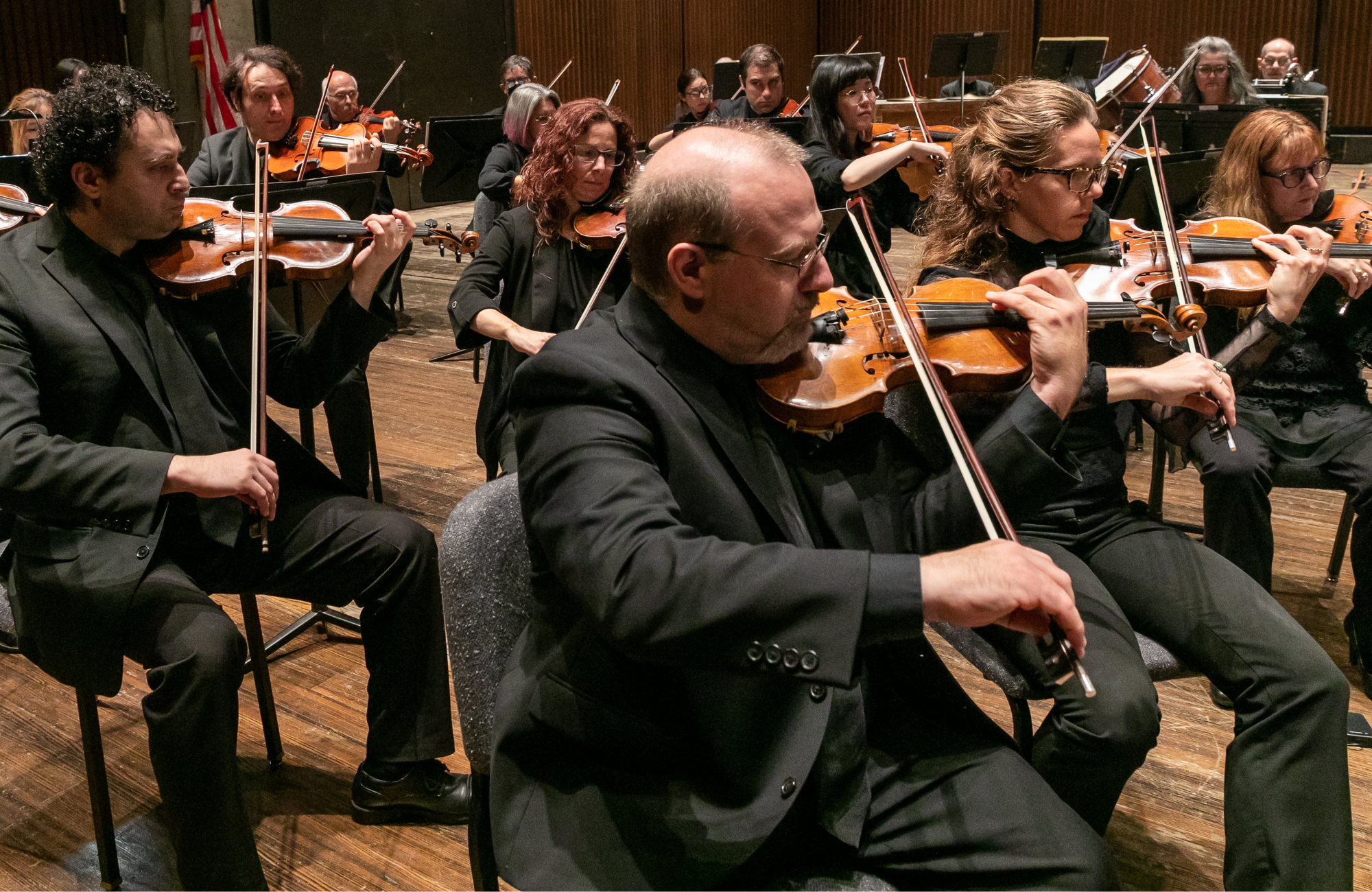Welcome spring with concertmaster Peter Rovit, who is featured as soloist and conductor, and works that showcase the Symphoria strings in sparkling baroque masterpieces.
PROGRAM
WASSENAER: Concerto Armonico No. 2 in B flat
Peter Rovit & Amy Christian, violins; Heidi Hoffman, cello
MATTHEIS: Diverse bizzarie sopra la Vecchia Sarabanda o pur Ciaccona
Amy Christian, violin; Heidi Hoffman, cello; Kenneth Meyer, guitar;
Michael W. Bull, percussion
BIBER: Sonatea tam aris qualm aulis servientes – Sonata No. 8
Peter Rovit & Amy Christian, violins; Arvilla Wendland & Carol Sasson, violas;
Heidi Hoffman & Gregory Wood, cellos; Kenneth Meyer, guitar
CAZZATI: Ciaccona
Peter Rovit & Edgar Tumajyan, violins; Heidi Hoffman, cello; Kenneth Meyer, guitar
CORELLI: Concerto Grosso Op. 6, No. 7 in D Major
Peter Rovit & Amy Christian, violins, Heidi Hoffman, cello
PURCELL: Three parts upon a Ground
Peter Rovit, Sonya Stith Williams, and Amy Christian, violins;
Heidi Hoffman, cello; Kenneth Meyer, guitar
HANDEL: Concerto Grosso No. 11 in A Major
Peter Rovit & Amy Christian, violins; Heidi Hoffman, cello
PROGRAM NOTES
The title of this afternoon’s concert—“Baroque Brilliance”—reminds us that the baroque period was a time of instrumental virtuosity; and if the piano was the romantic period’s instrument par excellence, the baroque’s was the violin. It’s therefore appropriate that the violin dominates this afternoon’s concert. But the baroque period was also a time when authorship was not as well protected as it is today, and a time when composers were less concerned with giving musicians precise directions in the way Mahler and Debussy did. As a result, there tends to be less certainty ...
The title of this afternoon’s concert—“Baroque Brilliance”—reminds us that the baroque period was a time of instrumental virtuosity; and if the piano was the romantic period’s instrument par excellence, the baroque’s was the violin. It’s therefore appropriate that the violin dominates this afternoon’s concert. But the baroque period was also a time when authorship was not as well protected as it is today, and a time when composers were less concerned with giving musicians precise directions in the way Mahler and Debussy did. As a result, there tends to be less certainty both about whose music is being played and how it should be performed. So it’s also perhaps appropriate that we open with a work that raises both of these issues.
Count Unico Wilhelm van Wassenaer (1692–1766), a Dutch statesman for whom music was a sideline, was pretty much forgotten after his death. In fact, he was doubly forgotten, since when one of his pieces unexpectedly became a posthumous hit in 1920, he didn’t even get credit. Stravinsky adapted the final movement of the Concerto Armonico No. 2 in B flat (published in 1740) as the Tarantella for his 1920 ballet Pulcinella; but at the time, it was attributed to Pergolesi. Today, we’ll get to hear it, properly attributed (we hope!), in its original orchestration and its original context.
As for how to perform it: the Concerto Armonico is open to at least two radically different options. It can be played either as a concerto grosso (a concerto for multiple soloists—in this case, two violinists—and orchestra) or as large-scale chamber music with six more or less independent parts over a continuo. This afternoon, you’ll hear it as a double concerto, its brilliance evident from the very first movement, notable for the intricate way the soloists play off each other. The second movement is perhaps even more contrapuntal, while the poignant third movement gives us a chance to catch our breaths before the rollicking finale. It’s obvious why Stravinsky was so taken with it.
Toward the center of the program we have the eighth sonata from the 1676 Sonatae tam aris quam aulis servientes (“Sonatas as Much for the Altar as for the Table”) by Heinrich Ignaz Franz von Biber (1644–1704). Biber was a virtuoso violinist—arguably the Heifetz of his day—whose solo violin music greatly influenced Bach. He, too, lost ground after his death; much of his music has disappeared, and authorship of some of it is disputed. But of what remains, the most popular works are known for quirkiness and spectacle. If you were here for our Casual in January 2018, you may remember his Battalia, with its imaginative use of instruments to imitate the sounds of battle and its depiction of drunken soldiers carousing, a depiction that involved superimposing a number of different popular songs in different keys. Biber is also remembered for violin works requiring scordatura (a tuning of the strings that departs from the usual one) as well as for a gigantic Mass that demanded two choruses (each in eight parts), seven instrumental groups, and several organs, all antiphonally placed around the cathedral. This afternoon’s sonata for strings is not so overtly striking. But you’d probably guess that it’s not quite straightforward, either. In fact, it has a mild whiplash effect: although it’s short and framed as a single movement, it changes style, meter, and mood with rapidity, interleaving largely contrapuntal music with music inspired by dance, so you never know what’s coming next.
Unlike Biber and Wassenaer, Arcangelo Corelli (1653–1713) and George Frideric Handel (1685–1759) never went out of style—so they need less of an introduction. Like Biber, Corelli was a virtuoso violinist, and some of his most brilliant music is found in his set of twelve Concerti Grosso, op. 6, published shortly after his death—concerto grossi with solo parts for two violins and cello, models of the genre that influenced many later composers. The most popular of Corelli’s set is No. 8, the “Christmas Concerto,” but today we’ll be hearing No. 7. Besides the virtuosic interplay of the three soloists, listen for the contrapuntal imagination of the fourth movement fugue and the infectious dance that sweeps the concerto to its conclusion. Handel’s Concerti Grosso, op. 6 (1739) are among those modelled on Corelli’s—indeed, he probably chose the opus number as a deliberate homage. Our program concludes grandly with the eleventh of the set, adapted from an earlier concerto for organ. The work opens with a French Overture (a slow movement marked by dotted rhythms followed by a quicker fugue), followed by a brief slow movement leading to a lyrical Andante. A high-spirited finale winds things up; if you think you’re hearing imitations of bird calls, you won’t be the only one.
Scattered among these four offerings are three works on a smaller scale: the Diverse bizzarie sopra la Vecchia Sarabanda o pur Ciaccona by Nicola Matteis (or Mattheis) (c. 1670–after 1713); the Ciaccona by Maurizio Cazzati (1616–1678); and Three Parts upon a Ground by the more familiar Henry Purcell (c. 1659–1695). All three are chaconnes (or passacaglias—the terms are generally used interchangeably), meaning that they consist of a series of variations set over a repeated bass. The form was a favorite of such later composers as Brahms (the finale of the Fourth Symphony is a chaconne), Britten, and Shostakovich—and today’s concert gives you a chance to hear the radically different ways three early practitioners put it to use.
By the way, if you’re used to seeing a harpsichord as a continuo instrument, you may be surprised to see that role taken by guitar this afternoon. In fact, the guitar was a common continuo instrument in the seventieth century, and we think it will give today’s concert a slightly different flavor—as will the drum in the Matteis.
Peter J. Rabinowitz—Have any comments or questions? Contact me at prabinowitz@ExperienceSymphoria.org
FEATURED ARTISTS

Violinist Peter Rovit (BM, Indiana University; MM, Hartt School; Professional Studies, Juilliard; DMA, SUNY Stony Brook) was among the last students of Josef Gingold at Indiana University where he also studied Baroque violin with Stanley Ritchie. Other teachers have included Mitchell Stern, Philip Setzer (Emerson Quartet), Cho-Liang Lin, Paul ...
Violinist Peter Rovit (BM, Indiana University; MM, Hartt School; Professional Studies, Juilliard; DMA, SUNY Stony Brook) was among the last students of Josef Gingold at Indiana University where he also studied Baroque violin with Stanley Ritchie. Other teachers have included Mitchell Stern, Philip Setzer (Emerson Quartet), Cho-Liang Lin, Paul Kantor and Donald Weilerstein. As a chamber musician, recitalist, and soloist he has performed throughout the United States and at music festivals such as Aspen, Taos, Yellow Barn, Hot Springs, Skaneateles, and Musical Spring in Saint Petersburg (Russia). A concerto competition winner at both the Hartt School and at SUNY Stony Brook, Mr. Rovit has also performed as a soloist with the Montgomery Symphony, the Fort Smith Symphony, the Oklahoma City Philharmonic, and the Tuscaloosa Symphony. He was a recipient of the prestigious Montgomery Symphony Violin Fellowship, has been a member of the Quartet Oklahoma, Associate Concertmaster of the Oklahoma City Philharmonic, and Concertmaster of the Tuscaloosa Symphony.
Mr. Rovit also loves to share his knowledge and experience with young musicians and has been on the string faculty of the University of Oklahoma and the University of Alabama. His students have gone on to study at such schools as Juilliard and Rice, and have won positions in professional orchestras, as well as the Chicago Civic Orchestra.
In his spare time, he enjoys reading, gardening, cooking, and finding imaginative ways to cook up those garden vegetables so that his children will eat them. Since having moved to Syracuse, he and his family have also enjoyed getting involved in winter sports such as snowshoeing, skating, and skiing.




